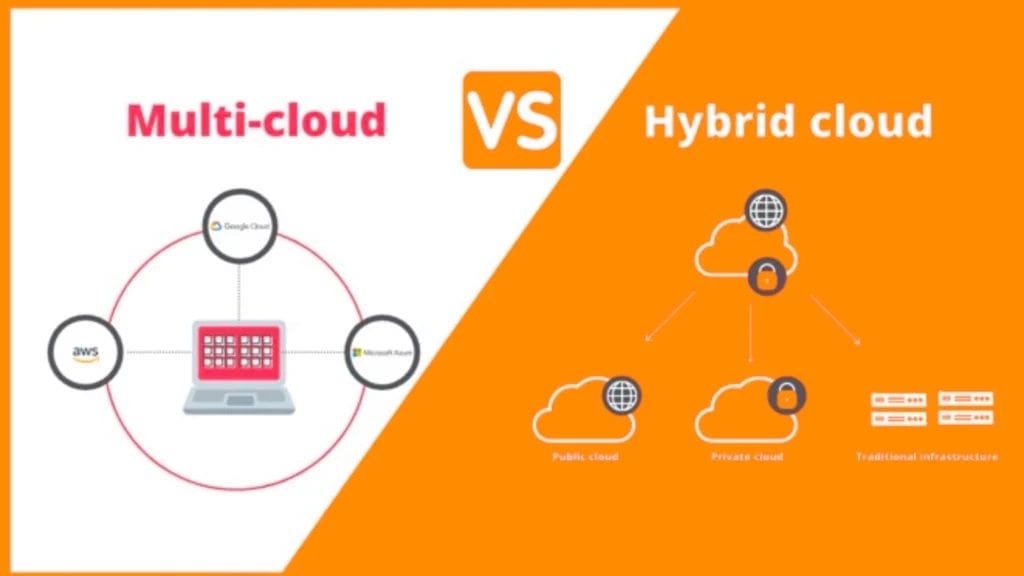Multi- and Hybrid-Cloud: Pro's & Con's and How to Choose the Right Approach
- Cloud

As businesses increasingly embrace cloud computing, the adoption of multi-cloud and hybrid cloud architectures is gaining momentum. A recent survey revealed that 70% of organizations are using or planning to use a multi-cloud or hybrid cloud strategy. This shift is driven by the desire for flexibility, scalability, risk mitigation, and cost optimization.
This blog post delves into multi- and hybrid cloud architectures, exploring the benefits, challenges, and factors to consider when choosing between these approaches.
Multi-Cloud Architectures
What is a Multi-Cloud Architecture?
Multi-cloud architecture refers to the practice of utilizing multiple cloud computing services from different providers to meet specific business needs. Unlike hybrid-cloud architecture, which combines both public and private clouds, multi-cloud involves using multiple public cloud providers. This approach offers several advantages, including enhanced redundancy, improved performance, and increased flexibility. By leveraging different cloud providers, organizations can avoid vendor lock-in and take advantage of the unique features and pricing models offered by each provider. However, managing multiple cloud environments can be complex and requires careful planning and coordination. It is crucial to consider factors such as data migration, security, and cost optimization when choosing the right approach for your organization’s specific requirements.
Multi-Cloud Architecture: Pro's and Con's
Multi-cloud architecture offers several advantages that make it an attractive option for businesses. One of the key pros of multi-cloud architecture is increased flexibility and scalability. By using multiple cloud providers, organizations can distribute their workloads across different platforms, enabling them to leverage the unique features and capabilities of each provider. This not only enhances performance but also reduces the risk of vendor lock-in. Additionally, multi-cloud architecture helps mitigate the impact of service disruptions or outages by providing redundancy and ensuring business continuity. With careful planning and management, businesses can harness the power of multi-cloud architecture to optimize costs, improve security, and deliver a seamless user experience.
While multi-cloud architecture offers many benefits, it is important to consider its drawbacks as well. One of the main cons of multi-cloud architecture is the increased complexity it introduces. Managing multiple cloud providers and integrating different services can be challenging and require specialized skills. Additionally, there may be compatibility issues between different cloud platforms, making it difficult to seamlessly transfer data and applications. Another disadvantage is the potential for increased costs, as using multiple cloud providers can lead to higher expenses for data transfer and management. Despite these challenges, with careful planning and consideration of your organization’s specific needs, multi-cloud architecture can still be a viable option that offers flexibility, redundancy, and scalability.
Hybrid-Cloud Architecture
What is a Hybrid-Cloud Architecture?
Hybrid-cloud architecture is a strategic approach that combines the benefits of both public and private clouds. In this model, organizations can leverage the scalability and cost-effectiveness of public clouds while also maintaining control over sensitive data and applications in a private cloud. The key advantage of hybrid-cloud architecture is its flexibility, allowing businesses to optimize their IT infrastructure based on their specific needs. By distributing workloads across different cloud environments, organizations can achieve improved performance, increased security, and enhanced reliability. However, choosing the right approach requires careful consideration of factors such as data sensitivity, compliance requirements, and cost-effectiveness. It is essential to assess the unique needs and goals of your business to determine the most suitable hybrid-cloud architecture that will maximize its potential.
Hybrid-Cloud Architecture: Pro's and Con's
Hybrid-cloud architecture offers numerous advantages that make it an increasingly popular choice for businesses. One major benefit is the flexibility it provides, allowing organizations to leverage the benefits of both public and private clouds. This means that sensitive data can be stored securely on a private cloud, while non-sensitive data can be stored on a cost-effective public cloud. Additionally, hybrid-cloud architecture offers scalability, as businesses can easily scale their resources up or down based on their needs. Furthermore, it provides a higher level of reliability and redundancy, as it allows for workload distribution across multiple cloud environments. By combining the best aspects of both multi-cloud and private cloud approaches, hybrid-cloud architecture empowers businesses to optimize their IT infrastructure and achieve a seamless and efficient cloud strategy.
Hybrid-cloud architectures offer numerous benefits. However, companies also need to evaluate the disadvantages in order to choose the right approach. One of the main cons of hybrid-cloud architecture is the complexity it introduces. Managing multiple cloud environments and integrating them with on-premises infrastructure can be challenging and require specialized skills. Additionally, the increased complexity can also lead to higher costs, as organizations may need to invest in additional resources and tools to effectively manage the hybrid-cloud environment. Security is another concern with hybrid-cloud architecture, as it introduces potential vulnerabilities and requires careful management of access controls and data protection measures. Despite these challenges, with proper planning and implementation, hybrid-cloud architecture can offer the best of both worlds, allowing organizations to leverage the scalability and flexibility of the public cloud while maintaining control over sensitive data and applications.
Factors to Consider When Selecting Between Multi- and Hybrid-Cloud
When considering the choice between multi-cloud and hybrid-cloud architectures, there are several important factors to consider. Multi-cloud architecture involves using multiple public cloud providers to distribute workloads and data, while hybrid-cloud architecture combines public and private clouds to create a flexible and customizable infrastructure. One key factor to consider is the level of control and security required for your data. Hybrid-cloud architecture allows for greater control and security as sensitive data can be kept on-premises. Another factor to consider is cost optimization. Multi-cloud architecture can offer cost savings by leveraging the best pricing options from different providers. Lastly, consider the complexity of managing multiple cloud environments. Hybrid-cloud architecture may require more effort to manage and integrate different platforms. By carefully evaluating these factors, you can choose the approach that best suits your organization’s needs and goals.

Assessing Your Organization's Needs and Goals
Assessing your organization’s needs and goals is a critical step in determining the right cloud architecture approach for your business. Multi-cloud and hybrid-cloud are two popular options, each with its own pros and cons. By evaluating your requirements, such as scalability, security, and cost-effectiveness, you can make an informed decision. Multi-cloud offers flexibility and redundancy by leveraging multiple cloud providers, while hybrid-cloud combines the benefits of both public and private clouds. Understanding your organization’s specific needs and aligning them with the advantages and limitations of each approach will help you select the most suitable cloud architecture for your business.
Evaluating Cost and Scalability
When evaluating cost and scalability in multi- or hybrid-cloud architecture, there are several factors to consider in order to choose the right approach for your organization. Multi-cloud architecture offers the advantage of flexibility, allowing you to select different cloud providers for different services based on cost and performance. This can help optimize costs and ensure scalability by leveraging the strengths of each provider. On the other hand, hybrid-cloud architecture combines both public and private clouds, offering increased control and security. However, it may require additional investment in infrastructure and maintenance. By carefully assessing your organization’s needs and considering factors such as budget, workload requirements, and data sensitivity, you can make an informed decision that strikes the right balance between cost and scalability for your business.
Making the Right Decision for Your Business
Making the right decision for your business when it comes to choosing between multi-cloud and hybrid-cloud architectures is crucial. Each approach has its pros and cons, and understanding them will help you determine which one aligns best with your business needs. Multi-cloud architecture offers the flexibility of using multiple cloud providers, allowing you to leverage the strengths of each provider and avoid vendor lock-in. On the other hand, hybrid-cloud architecture combines both public and private cloud environments, providing greater control and security for sensitive data. By carefully evaluating your business requirements and considering factors such as cost, scalability, data privacy, and regulatory compliance, you can make an informed decision that optimizes your cloud strategy and supports your long-term business goals.
ELASTECH is recognized for delivering powerful cloud architecture solutions that enable businesses with the freedom to move, develop, and enhance applications across hybrid and multi-cloud environments while avoiding vendor lock-in, deploying best-in-class solutions, and adhering to regulatory requirements. Our cloud architects will determine the best strategy for your success. Click below to schedule a free consultation.
Schedule Your Free Consultation with a Cloud Expert